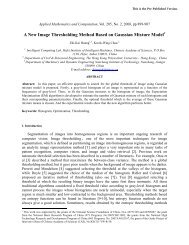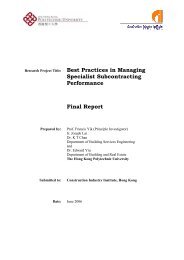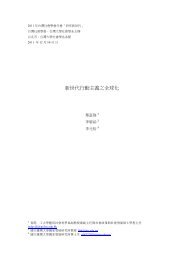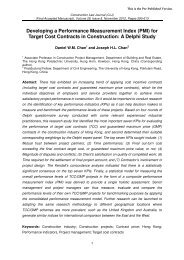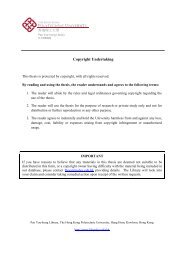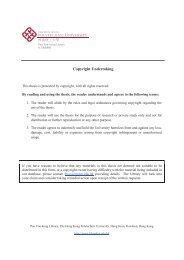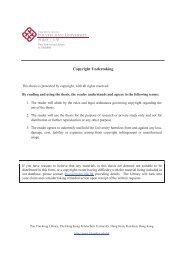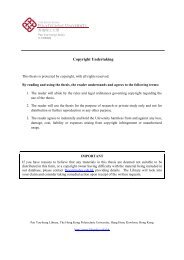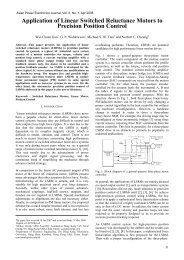Water-induced degradation in lead zirconate titanate piezoelectric ...
Water-induced degradation in lead zirconate titanate piezoelectric ...
Water-induced degradation in lead zirconate titanate piezoelectric ...
Create successful ePaper yourself
Turn your PDF publications into a flip-book with our unique Google optimized e-Paper software.
APPLIED PHYSICS LETTERS VOLUME 80, NUMBER 19 13 MAY 2002<br />
<strong>Water</strong>-<strong><strong>in</strong>duced</strong> <strong>degradation</strong> <strong>in</strong> <strong>lead</strong> <strong>zirconate</strong> <strong>titanate</strong> <strong>piezoelectric</strong> ceramics<br />
W. P. Chen a) and H. L. W. Chan<br />
Department of Applied Physics, Hong Kong Polytechnic University, Hong Kong, People’s Republic of Ch<strong>in</strong>a<br />
F. C. H. Yiu, K. M. W. Ng, and P. C. K. Liu<br />
Piezoelectrics Research Laboratory, ASM Assembly Automation Ltd., Watson Center, 16 Kung Yip Street,<br />
Kwai Chung, Hong Kong, People’s Republic of Ch<strong>in</strong>a<br />
Received 9 January 2002; accepted for publication 19 March 2002<br />
<strong>Water</strong>-<strong><strong>in</strong>duced</strong> <strong>degradation</strong> <strong>in</strong> <strong>lead</strong> <strong>zirconate</strong> <strong>titanate</strong> PZT <strong>piezoelectric</strong> ceramics was studied by a<br />
comparison experiment. In one treatment, PZT r<strong>in</strong>gs were immersed <strong>in</strong> a 0.01 M NaOH solution for<br />
long periods of time; <strong>in</strong> the other treatment, PZT r<strong>in</strong>gs were placed <strong>in</strong> a 0.01 M NaOH solution and<br />
hydrogen was evolved onto their silver electrodes by the electrolysis of water. No <strong>degradation</strong><br />
occurred to samples immersed <strong>in</strong> the NaOH solution; but for the samples that were also treated by<br />
electrolysis of water, serious <strong>degradation</strong> occurred as their mechanical quality factor decreased<br />
dramatically and their dielectric loss <strong>in</strong>creased considerably. I – V measurement showed that the<br />
resistance decreased greatly <strong>in</strong> the degraded samples, which could be expla<strong>in</strong>ed by the formation of<br />
charge carriers due to the reduction reaction of atomic hydrogen from the electrolysis of water. It<br />
was proposed that the reduction reaction of atomic hydrogen at ambient temperature is an important<br />
orig<strong>in</strong> for the <strong>degradation</strong> of <strong>piezoelectric</strong> ceramic devices. © 2002 American Institute of Physics.<br />
DOI: 10.1063/1.1479205<br />
Piezoelectric ceramics, namely poled polycrystall<strong>in</strong>e ferroelectrics,<br />
have been successfully developed for applications<br />
<strong>in</strong> numerous electromechanical devices, such as ultrasonic<br />
transducers, resonators, sensors, ultrasonic motors,<br />
actuators, and transformers. 1 It is expected that many other<br />
devices will also be fabricated us<strong>in</strong>g <strong>piezoelectric</strong> ceramics.<br />
One of the major challenges <strong>in</strong> the cont<strong>in</strong>u<strong>in</strong>g development<br />
of <strong>piezoelectric</strong> ceramics has been to improve the stability<br />
and reliability of <strong>piezoelectric</strong> ceramic devices. The properties<br />
of <strong>piezoelectric</strong> devices, especially those work<strong>in</strong>g under<br />
high stress and high field, usually exhibit obvious <strong>degradation</strong><br />
over the course of their lifetime. Sometimes sudden failure<br />
even occurs to devices <strong>in</strong> service. Degradation <strong>in</strong> <strong>piezoelectric</strong><br />
ceramic devices is a rather complicated process.<br />
Large mechanical vibration <strong><strong>in</strong>duced</strong> by high electric field<br />
may cause the formation of microcracks <strong>in</strong> <strong>piezoelectric</strong> devices.<br />
The formation and propagation of the microcracks<br />
cause damage to the devices. Another important source of<br />
<strong>degradation</strong> is depolarization, especially for those devices<br />
which undergo a substantial rise <strong>in</strong> temperature by the heat<br />
generated dur<strong>in</strong>g operation. 2 Degradation is also <strong>in</strong>fluenced<br />
by environmental factors, <strong>in</strong>clud<strong>in</strong>g temperature, pressure,<br />
and humidity. It was reported that the lifetime of <strong>piezoelectric</strong><br />
devices decreases dramatically with <strong>in</strong>creased temperature<br />
and humidity. 3<br />
Though many <strong>in</strong>vestigations have been carried out to<br />
study the <strong>degradation</strong> mechanisms of <strong>piezoelectric</strong> ceramic<br />
devices and much valuable knowledge has been obta<strong>in</strong>ed,<br />
some aspects of the <strong>degradation</strong> process rema<strong>in</strong> unclear. It is<br />
generally believed that the role of water <strong>in</strong> the <strong>degradation</strong><br />
process lies <strong>in</strong> the fact that water facilitates the electromigration<br />
of silver electrodes along the gra<strong>in</strong> boundaries of <strong>piezoelectric</strong><br />
ceramics. 3,4 In other words, water ma<strong>in</strong>ly reacts with<br />
a Electronic mail: apchenwp@polyu.edu.hk<br />
the metallic component of the devices. Some recent studies,<br />
however, show that, <strong>in</strong> the presence of electricity, water has a<br />
more profound <strong>in</strong>fluence on the ceramic bodies of <strong>lead</strong>-based<br />
relaxor ferroelectric multilayer ceramic capacitors and<br />
(Ba,Pb)TiO 3 -based thermistors and <strong>lead</strong>s to serious<br />
<strong>degradation</strong>. 5,6 This <strong>in</strong>dicates that the role of water <strong>in</strong> the<br />
<strong>degradation</strong> of electroceramic devices should not be simply<br />
limited to the electromigration of the silver electrodes. Reaction<br />
between water and electroceramics should receive much<br />
more attention and should be studied <strong>in</strong>-depth. The present<br />
study aims to <strong>in</strong>vestigate the reaction between water and <strong>piezoelectric</strong><br />
ceramics and study its effect on the properties of<br />
the <strong>piezoelectric</strong> ceramic-based devices.<br />
Lead <strong>zirconate</strong> <strong>titanate</strong> PZT ceramic r<strong>in</strong>gs, Morgan<br />
PZT-8 with an approximate composition of<br />
Pb(Zr 0.4 Ti 0.6 )O 3 , together with a number of dopants, from<br />
Morgan Electro Ceramics USA were used <strong>in</strong> the experiment.<br />
The r<strong>in</strong>gs were 2.30 mm thick, with an <strong>in</strong>ner and outer<br />
radius of 2.50 and 6.35 mm, respectively. Silver electrode<br />
was coated on the two major surfaces of the r<strong>in</strong>gs. The r<strong>in</strong>gs<br />
were poled <strong>in</strong> the thickness direction and were suitable for<br />
application as Langev<strong>in</strong> sandwich transducers <strong>in</strong> a wire<br />
bond<strong>in</strong>g mach<strong>in</strong>e. 7 Two different treatments were performed<br />
on the r<strong>in</strong>gs for comparison. In the first treatment, some<br />
samples were immersed <strong>in</strong> a 0.01 M NaOH solution for some<br />
long periods of time and then taken out, washed by deionized<br />
water, and dried. In the second treatment, some r<strong>in</strong>gs<br />
were placed <strong>in</strong> a 0.01 M NaOH solution and dc voltages<br />
were applied between the silver electrode of the r<strong>in</strong>gs and an<br />
anode <strong>in</strong> the solution. Electrolysis of water occurred due to<br />
the applied dc voltages and hydrogen was evolved on the<br />
silver electrode of the r<strong>in</strong>gs while oxygen was evolved on the<br />
anode. So this treatment is referred to as ‘‘hydrogen charg<strong>in</strong>g’’<br />
hereafter. The solution was kept agitated by a magnetic<br />
agitator and the temperature was kept constant at 25 °C. The<br />
0003-6951/2002/80(19)/3587/3/$19.00 3587<br />
© 2002 American Institute of Physics
3588 Appl. Phys. Lett., Vol. 80, No. 19, 13 May 2002 Chen et al.<br />
dc voltages were removed after some designated periods of<br />
time and the samples were taken out, washed and dried.<br />
Impedance/phase versus frequency spectra of the PZT r<strong>in</strong>gs<br />
were measured by an Agilent 4294 A impedance analyzer.<br />
I – V characteristics of the r<strong>in</strong>gs were recorded by a Keithley<br />
237 dc source/measure unit. A ZJ-3D piezo d 33 meter manufactured<br />
by Beij<strong>in</strong>g Institute of Acoustics, Ch<strong>in</strong>a was used<br />
to measure the <strong>piezoelectric</strong> charge coefficient d 33 of the<br />
r<strong>in</strong>gs. Microstructural analyses were carried out by a scann<strong>in</strong>g<br />
electron microscope STEROSCAN 440.<br />
Microstructural analyses showed that the PZT r<strong>in</strong>gs were<br />
of a very dense microstructure. It was difficult for water to<br />
permeate <strong>in</strong>to the r<strong>in</strong>gs. Accord<strong>in</strong>gly, no noticeable change<br />
could be observed <strong>in</strong> the properties of the r<strong>in</strong>gs after the first<br />
treatment. It should be po<strong>in</strong>ted out that some r<strong>in</strong>gs have been<br />
immersed <strong>in</strong> the NaOH solution for 20 days. These facts<br />
suggest that, <strong>in</strong> the absence of an electric field, the dilute<br />
NaOH solution does not <strong>in</strong>fluence the PZT r<strong>in</strong>gs by permeation.<br />
In contrast, serious <strong>degradation</strong> occurred <strong>in</strong> those<br />
samples treated by hydrogen charg<strong>in</strong>g. The PZT r<strong>in</strong>gs vibrate<br />
<strong>in</strong> the thickness mode when they are used <strong>in</strong> a wire bond<strong>in</strong>g<br />
mach<strong>in</strong>e. The impedance/phase spectra of the thickness vibration<br />
mode for an as-received PZT r<strong>in</strong>g is shown <strong>in</strong> Fig.<br />
1a. The peak of m<strong>in</strong>imum impedance corresponds to the<br />
resonance of the thickness vibration mode. The impedance<br />
and the frequency of the peak are the resonance impedance<br />
Z r and the resonance frequency f r , respectively. The peak of<br />
maximum impedance corresponds to the anti-resonance of<br />
the thickness vibration mode. The impedance and the frequency<br />
of the peak are the anti-resonance impedance Z a and<br />
the antiresonance frequency f a , respectively. The r<strong>in</strong>g was<br />
then placed <strong>in</strong> 0.01 M NaOH solution and subjected to a dc<br />
voltage of 3 V between its silver electrode and the anode <strong>in</strong><br />
the solution. Under this voltage the cathodic current density<br />
was around 0.2 mA/cm 2 . The treatment was <strong>in</strong>terrupted several<br />
times and the r<strong>in</strong>g was taken out for measurement after<br />
be<strong>in</strong>g dried. The impedance/phase spectra of the thickness<br />
vibration mode obta<strong>in</strong>ed <strong>in</strong> these measurements are shown <strong>in</strong><br />
Figs. 1b, 1c, and 1d. For these measurements, the hydrogen<br />
charg<strong>in</strong>g treatment was conducted for 40, 80, and 120<br />
h, respectively. It is clear that with <strong>in</strong>creased hydrogen charg<strong>in</strong>g<br />
time, the resonance impedance Z r <strong>in</strong>creases while the<br />
antiresonance impedance Z a decreases. Both the resonance<br />
frequency f r and the antiresonance frequency f a are shifted<br />
slightly to higher frequency after the hydrogen charg<strong>in</strong>g. The<br />
<strong>degradation</strong> of this PZT r<strong>in</strong>g can also be seen <strong>in</strong> the changes<br />
<strong>in</strong> the mechanical quality factor Q m , which is the reciprocal<br />
of the mechanical loss, and the dielectric loss at 1 kHz, as<br />
shown <strong>in</strong> Fig. 2. The mechanical quality factor Q m was calculated<br />
by the equivalent circuit method with the Agilent<br />
4294 A impedance analyzer. 8 The mechanical quality factor<br />
Q m decreases dramatically while the dielectric loss <strong>in</strong>creases<br />
considerably by the treatment, which implies that the treatment<br />
will cause more mechanical loss and more dielectric<br />
loss when the r<strong>in</strong>g is used <strong>in</strong> a wire bond<strong>in</strong>g mach<strong>in</strong>e.<br />
As no <strong>degradation</strong> occurred <strong>in</strong> those samples immersed<br />
<strong>in</strong> NaOH solution without the application of dc voltages, it<br />
can thus be concluded that the electrochemical reactions <strong><strong>in</strong>duced</strong><br />
by the dc voltages are the cause of the <strong>degradation</strong>.<br />
FIG. 1. Impedance/phase vs frequency spectra of the thickness vibration<br />
mode of a PZT r<strong>in</strong>g: a as-received, b after 40 h hydrogen charg<strong>in</strong>g, c<br />
after 80 h hydrogen charg<strong>in</strong>g, d after 120 h hydrogen charg<strong>in</strong>g.<br />
Hydrogen was evolved on the silver electrode of the PZT<br />
r<strong>in</strong>gs when dc voltages were applied, which can be written as<br />
H 2 Oe →OH H ads ,<br />
1<br />
H ads H ads →H 2 ,<br />
2<br />
where H ads represents an adsorbed hydrogen atom. Hydrogen<br />
atoms are very reactive and exist only as <strong>in</strong>termediate<br />
products. 9 Some of them may react with other matter encountered<br />
<strong>in</strong> their path, although most of them comb<strong>in</strong>e with<br />
one another to form hydrogen molecules. Some researchers<br />
have shown that atomic hydrogen generated by electrolysis<br />
of water can diffuse <strong>in</strong>to ceramics and <strong>in</strong>duce reduction reactions<br />
at ambient temperature, which greatly changes the<br />
properties of the ceramics. 5,6 The <strong>degradation</strong> of the PZT<br />
r<strong>in</strong>gs <strong>in</strong> this study can also be expla<strong>in</strong>ed by the reduction<br />
reaction of hydrogen atoms.<br />
Accord<strong>in</strong>g to some previous studies, the reduction reaction<br />
of atomic hydrogen results <strong>in</strong> the formation of charge
Appl. Phys. Lett., Vol. 80, No. 19, 13 May 2002<br />
Chen et al.<br />
3589<br />
FIG. 2. Dependence of the mechanical quality factor Q m and the dielectric<br />
loss 1 kHz on the hydrogen charg<strong>in</strong>g time.<br />
carriers <strong>in</strong> <strong>lead</strong>-based relaxor ferroelectric ceramics and<br />
greatly decreases the resistivity. 5,10 In this study, it was found<br />
that the resistivity of the degraded samples was also greatly<br />
decreased. Figure 3 shows the I – V measurement results obta<strong>in</strong>ed<br />
for the sample whose impedance spectra have been<br />
shown <strong>in</strong> Fig. 1. The two curves correspond to the two measurements<br />
taken for the as-received state and after 120 h of<br />
hydrogen charg<strong>in</strong>g. It is evident that the hydrogen charg<strong>in</strong>g<br />
treatment <strong>in</strong>creases the conductivity by about three orders of<br />
magnitude. It is well known that a high resistivity is of great<br />
importance for various <strong>piezoelectric</strong> applications, and the<br />
<strong>degradation</strong> observed <strong>in</strong> this study is obviously related to the<br />
<strong>in</strong>crease <strong>in</strong> the conductivity of the r<strong>in</strong>gs.<br />
Hydrogen gas reacts with PZT ceramics only at elevated<br />
temperatures. In this study, however, the reduction reaction<br />
occurred at ambient temperature. The cause of the reduction<br />
must have been atomic hydrogen rather than molecular hydrogen.<br />
The formation of atomic hydrogen at ambient temperature<br />
resulted from the application of dc voltages <strong>in</strong> this<br />
study. So electricity plays a vital role <strong>in</strong> the <strong>degradation</strong>.<br />
Some researchers proposed that hydrogen is <strong>in</strong>corporated<br />
<strong>in</strong>to (Ba,Sr)TiO 3 and PZT th<strong>in</strong> films when hydrogen reacts<br />
with them at relatively low temperatures below 550 °C. 11,12<br />
Similarly, it is reasonable to assume that hydrogen is <strong>in</strong>corporated<br />
<strong>in</strong>to PZT <strong>in</strong> this study and the reduction reaction can<br />
be expressed as<br />
H ads →H . i e ,<br />
3<br />
.<br />
where H i represents an <strong>in</strong>terstitial proton. It is assumed that<br />
hydrogen is <strong>in</strong> <strong>in</strong>terstitial sites and is ionized. Free electrons<br />
are formed so the resistivity is greatly decreased <strong>in</strong> the degraded<br />
samples. Further study of the reaction details is <strong>in</strong><br />
progress and the results will be reported elsewhere.<br />
The <strong>piezoelectric</strong> coefficient d 33 of the as-received PZT<br />
r<strong>in</strong>gs was around 21510 12 C/N. It is found that the hydrogen<br />
charg<strong>in</strong>g treatment has no noticeable <strong>in</strong>fluence on this<br />
coefficient. This <strong>in</strong>dicates that no depolarization occurred <strong>in</strong><br />
the degraded samples <strong>in</strong> this study. However, as the hydrogen<br />
charg<strong>in</strong>g decreases the mechanical quality factor and <strong>in</strong>creases<br />
the dielectric loss of the PZT r<strong>in</strong>gs, a greater temperature<br />
rise will occur when the r<strong>in</strong>gs vibrate under<br />
electrical driv<strong>in</strong>g, which <strong>in</strong> turn will enhance depolarization.<br />
FIG. 3. Influence of hydrogen charg<strong>in</strong>g on the I – V characteristics of a PZT<br />
r<strong>in</strong>g.<br />
In summary, this study clearly shows that water causes<br />
serious <strong>degradation</strong> of <strong>lead</strong> <strong>zirconate</strong> <strong>titanate</strong> <strong>piezoelectric</strong><br />
ceramics through the reduction reaction of atomic hydrogen.<br />
Some researchers have demonstrated that a th<strong>in</strong> water film<br />
can form on the surface of ceramic components by condensation<br />
of aqueous vapor <strong>in</strong> air. 13 When <strong>piezoelectric</strong> ceramic<br />
devices are operated under some voltage and a th<strong>in</strong> water<br />
film is present, atomic hydrogen can be formed by electrolysis<br />
of water, which <strong>in</strong> turn <strong>lead</strong>s to <strong>degradation</strong> of the devices<br />
by the reduction reaction. So the reaction between atomic<br />
hydrogen and <strong>piezoelectric</strong> ceramics should be studied <strong>in</strong><br />
detail and efforts should be made to prevent water-<strong><strong>in</strong>duced</strong><br />
<strong>degradation</strong> of <strong>piezoelectric</strong> ceramic devices.<br />
This work has been supported by the Postdoctoral Research<br />
Fellowship Scheme and the Center for Smart Materials<br />
of the Hong Kong Polytechnic University. Support from<br />
the Innovation and Technology Fund ITF UIM/29 is also<br />
acknowledged. The authors appreciate Dr. J. Emil’s help <strong>in</strong><br />
the measurement of the I – V curves.<br />
1 G. H. Haertl<strong>in</strong>g, J. Am. Ceram. Soc. 82, 7971999.<br />
2 M. D. Hill, G. S. White, and C. S. Hwang, J. Am. Ceram. Soc. 79, 1915<br />
1996.<br />
3 J. Thongrueng, T. Tsuchiya, and K. Nagata, Jpn. J. Appl. Phys., Part 1 37,<br />
5306 1998.<br />
4 J. M. Herbert, <strong>in</strong> Ceramic Dielectrics and Capacitors, editedbyD.S.<br />
Campbell Gordon and Breach, New York, 1985.<br />
5 W. P. Chen, L. T. Li, Y. Wang, and Z. L. Gui, J. Mater. Res. 13, 1110<br />
1998.<br />
6 W. P. Chen, L. T. Li, J. Q. Qi, and Z. L. Gui, J. Mater. Sci. Lett. 17, 899<br />
1998.<br />
7 S. W. Or, H. L. W. Chan, V. C. Lo, and C. W. Yuen, Sens. Actuators A 65,<br />
69 1998.<br />
8 D. A. Berl<strong>in</strong>gcourt, D. R. Curran, and H. Jaffe, Physical Acoustics, edited<br />
by W. P. Mason Academic, New York, 1964, Vol. 1, Part A.<br />
9 C. J. Raub, Plat<strong>in</strong>g and Surface F<strong>in</strong>ish<strong>in</strong>g 80, 301993.<br />
10 J. L. Cao, L. T. Li, and Z. L. Gui, J. Mater. Chem. 11, 1198 2001.<br />
11 J. H. Ahn, P. C. Mclntyre, L. W. Mirkarimi, S. R. Gilbert, J. Amano, and<br />
M. Schulberg, Appl. Phys. Lett. 77, 1378 2000.<br />
12 S. Aggarwal, S. R. Perusse, C. W. Tipton, R. Ramesh, H. D. Drew, T.<br />
Venkatesan, D. B. Romero, V. B. Podobedov, and A. Weber, Appl. Phys.<br />
Lett. 73, 1973 1998.<br />
13 Y. C. Chan and F. Yeung, IEEE Trans. Compon., Packag., Manuf. Technol.,<br />
Part C 19, 138 1996.



